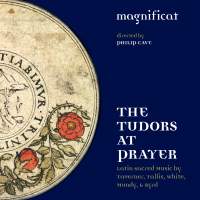Texte paru dans: / Appeared in:

Fanfare Magazine: 38:2 (11-12/2014)
Pour
s'abonner / Subscription information
Les abonnés à Fanfare Magazine ont accès aux archives du
magazine sur internet.
Subscribers to Fanfare Magazine have access to the archives of the magazine
on the net.
Linn
CKD447

Code-barres / Barcode : 0691062044721
I have long been in awe of this music, and of those who perform it, because it is not easy to do it well. Magnificat is an ensemble that has made several discs for Linn Records and other labels, and they (the ensemble and the discs!) have been received warmly in Fanfare. On this outing, 18 singers are credited as ensemble members, so it is a smaller group than the Taverner Choir when it recorded Tallis’s Suscipe, quaeso Domine for EMI in the 1980s. The other comparison disc I pulled out is Gimell CDGIM 339, which includes Mundy’s Vox Patris caelestis as a coupling to the Tallis Scholars’ famous recording of Allegri’s Miserere. I can’t find any information about how many Scholars participated in that recording, however, but I think it was a smaller group than Magnificat.
With the exception of John Taverner, who was a little older, all of these composers were alive in 1560, a tumultuous period in English history, not least for sacred composers who self-identified as Roman Catholics, or who composed music in that style. The only thing the present disc lacks is variety. Listening to it in one sitting is like sitting in the surf and being engulfed by one wave after another. The dense polyphony creates a hypnotic and spiritual effect. (I understand that one of the complaints made by the Protestants about this music is that it was so dense it was impossible to understand the words—and not just because the words were Latin.) Take it slowly and one work at a time, and each work will reveal its unique beauties.
Looking at, or rather listening to, Vox patrix caelestis, one immediately notices that the Tallis Scholars perform it at a much higher pitch than Magnificat, and this brightens the music’s colors considerably. This also puts soprano Alison Stamp (I think it is her) way up into the stratosphere at several points, but she has no fear, and the music rings out securely. There’s more ebb and flow in the Tallis Scholars’ singing, more dynamic contrast, and a greater sense of devotion. Also, the Tallis Scholars are not recorded so closely, so there is more atmosphere. While there is nothing wrong with Magnificat’s reading of this work, the Tallis Scholars knock them out of the ballpark.
Turning to Suscipe, quaeso Domine, again I find the competition preferable to Magnificat, and for the same reasons. The Taverner Choir sings it at a higher pitch, at a faster tempo (8:37, vs. Magnificat’s 9:35), and with more flexibility, in terms of phrasing and dynamics. Magnificat’s sober, even dark singing sends one spiritual message, while the more soaring performances of the Tallis Scholars and the Taverner Choir send another. I think you can tell which message I prefer!
To be honest, I was perfectly happy with this disc until I pulled out the comparison discs. You are likely to be as well, but it would be a shame to deny yourself the radiance that other ensembles bring to this music, no matter what your religious beliefs might be.
Cliquez l'un ou l'autre
bouton pour découvrir bien d'autres critiques de CD
Click either button for many other reviews


